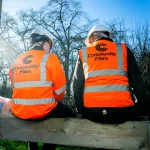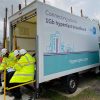Broadband Delivery UK Issues Strict Guidance for Wireless Networks
The government’s Broadband Delivery UK office has released new guidance for local authorities on the use of state aid (public funding) in support of deploying NGA fixed wireless access (FWA) networks. The guidance, much like existing EU rules, makes it possible for wireless ISPs to engage in the process but only under strict conditions.
As it stands today the only operators able to actually bid for public funding under the restrictive BDUK framework are BT and Fujitsu UK, although the latter has effectively withdrawn from the process over economic concerns; not to mention the government labelling any Fujtisu UK contract as “high risk” (here).
Advertisement
The government was last year also forced to admit that its maps of national broadband availability were flawed because they often excluded wireless networks (wifi, fixed LTE etc.) and instead focused almost exclusively on fixed line broadband connectivity (here).
Suffice to say that wireless networks which go hunting for state aid often start off from a position of weakness and, in that respect, the new guidance hopes to provide some much needed clarity.
The Criteria for NGA Wireless Networks
2.2 In assessing projects for State aid approval, BDUK’s National Competency Centre (“NCC”) requires that interim non-wired technologies that are used in NGA white intervention areas must provide the same outputs as those defined for NGA network deployments. Specifically, the NCC will expect to see that the technical solution:
• is capable of providing access speeds in excess of 30Mbps download, not only by reference to theory and technical standards, but also by evidence of calibrated performance measurements of an existing deployment within the area of interest or an demonstrably equivalent deployment in a similar geographical environment;
• provides a doubling of average access speeds in the target NGA intervention area;
• must be designed in anticipation of providing at least ~15Mbps download speed to end-users for 95% of the time during peak times in the target intervention area, as demonstrated by calibrated measurements using a methodology comparable to those used for fixed network measurements;
• must show how the solution would adapt to maintain capability an end-user experience in changes to key parameters such as increased take-up and increased demand for capacity, and be able to show that this is both technically and commercially viable supported by clear calculations;
• must have characteristics (e.g. latency, jitter) that enable advanced services to be delivered e.g. video-conferencing and High Definition video streaming to be provided to end users as evidenced by trials results not necessary obtained within the area of interest; and
• has longevity such that one might reasonably expect increases in performance within the next 7 years.
Interestingly though one of the requirements states that the subsidised solution must be an “interim solution chosen where a fibre-based solution is not yet economically viable, and there shall be a commitment to replace non-wired connections with fibre at a later stage“.. hmm.
Statement on Requirement 2
“This requirement ensures that public money is used to support infrastructures that offer the most viable route to full fibre infrastructure; where that goal isn’t economically viable today, any subsidised solution should support this goal eventually (i.e. when revenues increase or deployment costs decrease sufficiently).”
On the one hand we support the fact that full fibre optic broadband services are being taken seriously by the document, yet on the other it’s hard to see how this would work for an ISP whose primary business is with the speciality of fixed wireless provision. The new guidance is based off similar recommendations put forward by the EU (here).
Advertisement
It should however be said that BDUK isn’t the only model for state aid and operators can engage with councils and private funding solutions directly; not that they’ll have much luck there either. It’s also worth remembering that state aid is usually only issued to network developers that can offer an open access network for other ISPs.
Fixed Wireless Technology: BDUK Guidance (DOC)
https://www.gov.uk/../State_aid_guidance_-_Role_of_Fixed_Wireless.doc
Mark is a professional technology writer, IT consultant and computer engineer from Dorset (England), he also founded ISPreview in 1999 and enjoys analysing the latest telecoms and broadband developments. Find me on X (Twitter), Mastodon, Facebook, BlueSky, Threads.net and Linkedin.
« Sony PlayStation 4 Needs a Bigger and Faster Broadband Connection


















































Comments are closed